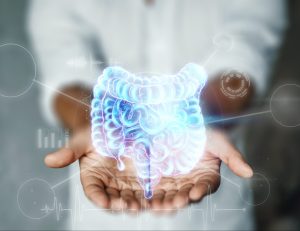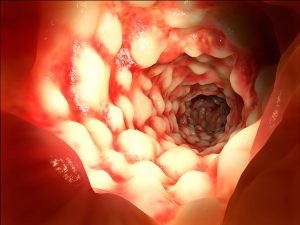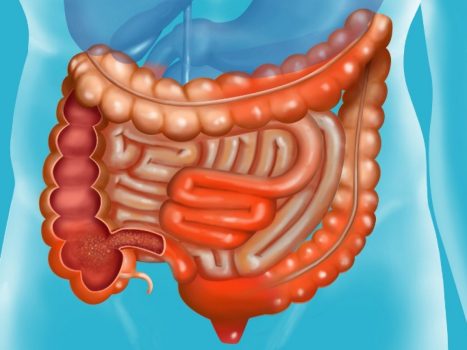✓ Glucomannan
Glucomannan is an herb that grows in Asia and that comes from the Konjac plant. Glucomannan is used as Crohn’s Disease Home Remedies because it is said to be a gentle, effective, natural soluble fiber that supports healthy colon function. It encourages a larger stool and requires less pressure to pass through the colon, which make it a bulk-forming natural laxative.
✓ Boswellia
Boswellia is known to be a very effective natural solution for Crohn’s disease. It comes from trees that produce sweet-smelling resin high in essential oils, boswellic acids and carbohydrates. The active ingredient is the acid found in the resin which is believed to be an anti-inflammatory agent.[1]
✓ Curcumin
For its antioxidant and antimicrobial properties, Curcumin is used to fight infections in people with Crohn’s Disease and maintain remission. The results of the many randomized clinical trials showed promising results with the use of curcumin as Crohn’s disease home remedies.[2]
Turmeric Powder, Turmeric Capsules
Recommendation: Try Curumin drops and Boswellia drops together ?
✓ Probiotics
Probiotics are beneficial bacteria that live throughout the body. They can help a person suffering from Crohn’s disease to create more anti-inflammatory bacteria.[3] You can increase your probiotic intake by including probiotic-rich foods in your diet, such as yogurt, sauerkraut, Kombucha and kefir, but you can also take food supplements.
✓ Bromelain
Bromelain consists of a mixture of enzymes from fruits, mainly from pineapple. Bromelain has been shown to reduce inflammation and Crohn’s symptoms in various studies.[4] Bromelain can be purchased in tablet form.
✓ Aloe Vera
Aloe vera is a so cool, so fresh and so soothing herb. It’s got a reputation for calming Crohn’s Disease and other IBS. Recent researches suggest that rectal application of aloe vera extract could reduce inflammation and promote healing during a flare-up. It is also recommend to take it everyday in smoothies.[5]
✓ Lavender Oil
Lavender essential oil is widely used to help regulate gut health in people with Crohn’s Disease by regulating the gut microbiome. Indeed, some studies indicate that lavender might help protect against Citrobacter rodentium, a gut bacterium associated with Crohn’s Disease.
✓ Peppermint Oil
Menthol, a substance present in peppermint essential oil, is known to help decrease inflammation and oxidative stress in people with Crohn’s Disease. You can diffuse it or topically apply with a carrier oil.


Crohn’s Disease Home Remedies
Crohn’s disease is a form of IBD that causes inflammation within the digestive tract. It can affect any segment of the digestive tract, from the mouth to the anus, but most commonly affects the small intestine (in its terminal part, the ileum), the colon and the anus. There is no cure for Crohn’s disease, but there are medications that may be able to ease the symptoms.
Symptoms include watery diarrhea or chronic bloody, abdominal pain, loss of appetite and fever. Symptoms may come and go, with the disease becoming active or going into remission several times during the person’s lifetime.
Crohn’s disease is a chronic inflammatory disease with phases of activity (or “flare-ups”) alternating with more or less complete and prolonged phases of remission, during which the patient no longer feels the disease. It is not contagious.[6]
Crohn’s disease is a relatively uncommon disease, but it is no less embarrassing and often very difficult to live with. Fortunately, there are natural methods that can help relieve the sufferers and slow down the disease. Yes, Crohn’s disease can be treated naturally!
Many natural remedies for crohns disease can be used to reduce the symptoms and improve the quality of life. You can also combine natural remedies with standard medical treatment.[7]
Furthermore, adopting a healthier diet will allow you to heal your digestive tract and relieve it. First and foremost, avoid sugar (especially refined sugar), which feeds the bad bacteria. On the other hand, many sufferers say they felt relief after they stopped consuming milk and gluten. For others, it would be “useless”. [8] Every patient can therefore try to eliminate milk and gluten from his or her diet and see for himself or herself whether or not this produces improvements.
Read more about Crohn’s disease : Wikipedia.
What is the trigger for Crohn's disease?
- Genetic predisposition: genes predisposing to Crohn's disease have been identified. Certain gene mutations increase the risk of developing the disease.
- An imbalance between the immune system and the intestinal microbiota (or gut flora): the immune system reacts abnormally against the bacteria normally present in the digestive tract. This leads to inflammation of the intestinal wall, which is present in Crohn's disease.
- The rapid increase in the number of new cases of Crohn's disease in industrialising countries suggests that the environment plays a role in triggering the disease. Among the environmental factors, smoking is the main known factor in the onset of Crohn's disease. Smoking increases the risk and severity of flare-ups and complicates treatment.
- Researchers also take into account diet, but its influence has not been proven for the moment
- Psychological stress is not, to date, recognised as an independent risk factor.
How do you get Crohn's disease?
The exact causes of Crohn's disease are not yet known. Diet and stress were once blamed, but scientists now believe that these are only aggravating factors. However, it is known that Crohn's disease is related to an interaction between the following three elements:
- an inappropriate immune system response: in people with inflammatory bowel disease ibd, such as Crohn's, the immune system reacts abnormally to the bacteria usually present in the digestive tract. This could be due to an imbalance in the intestinal flora, or to an infection by an external virus or bacteria. The result is inflammation of the intestinal wall;
- A genetic predisposition: certain genes are associated with a greater risk of developing Crohn's disease. However, genetics cannot predict precisely whether the disease will occur;
- Environmental factors: these are a trigger for the disease, acting as a catalyst for the immune system's reaction.
What does stool look like in Crohn's disease?
- Watery stools: greater difficulty in absorbing water and nutrients can cause diarrhoea. A person may have more frequent or very loose stools.
- Constipation: inflammation, especially of the anus and rectum, can make it harder to pass stools. This in turn can cause constipation. A person may notice that their stools are very hard.
- Blood in the stool: anal fissures or constipation can cause traces of red blood in the stool.
- Fatty stools: When the body cannot absorb nutrients such as fat, a person's stools may seem fatty or more viscous than usual.
Diarrhoea may be watery to viscous and may last for several weeks. It is sometimes accompanied by fever. The presence of blood in the stool is not diagnostic of Crohn's disease and is much less common than with ulcerative colitis.
What are the early warning signs of Crohn's disease?
A common characteristic of all patients is the appearance of abdominal pain, transit disorders, alternating between diarrhea - which does not affect all patients contrary to popular belief - and constipation.
Anal pain, fissures, fistulas or abscesses can also be a sign of the disease, as can sudden weight loss, loss of appetite, nausea and/or vomiting.
The symptoms of Crohn's disease appear during attacks, often unpredictably. Their intensity can vary from person to person, but also from one attack to another.
- During attacks, symptoms are often amplified during the food digestion process (after meals).
- Diarrhea and abdominal pain are the most common symptoms.
- The abdomen may be swollen and tender, stomach cramps may occur.
- Loss of appetite and weight loss are common.
- Rectal bleeding is not uncommon; if it is heavy, it can eventually lead to anemia, an iron deficiency characterized by paleness and weakness.
- Attacks may cause fever.
- Non-digestive symptoms may include joint pain, skin problems and eye inflammation.
How do I know that I have Crohn's disease?
The need to go to the bathroom frequently (ten times a day or more), significant weight loss and great fatigue are other symptoms associated with the disease. Apart from severe diarrhea, it is not uncommon to miss these signs, which, when taken in isolation, are quite common. Especially since the disease can also manifest itself in non-digestive forms (20% of cases) and affect other organs such as the joints or the skin.
In brief, the following symptoms may be signs of crohns and colitis:
- Abdominal pain, cramps;
- Diarrhea (bloody stools; with colitis);
- Nausea and vomiting;
- Decreased appetite and weight loss;
- Fever;
- Anemia;
- Fatigue.
What are 5 symptoms of Crohn's disease?
- Cramping abdominal pain
- Chronic diarrhea (sometimes bloody when the large intestine is severely affected)
- Fever
- Loss of appetite
- Loss of weight
Symptoms of Crohn's disease may last for several days or weeks and then disappear without treatment. Complete recovery from a single attack is rare. Crohn's disease almost always progresses in flare-ups at irregular intervals throughout life. Flare-ups may be moderate or severe in intensity, short or prolonged in duration. Severe relapses can result in severe, constant pain, fever and dehydration.
The reasons for the recurrence or severity of flare-ups and their triggers are not known. Recurrent inflammation tends to occur in the same area of the intestine. It may also occur in areas close to where a diseased segment was surgically removed.
How serious is Crohn's disease?
The main complications are:
- Abscess: Pus pocket in a tissue cavity ;
- Anemia: Blood loss in the stool can lead to iron or vitamin B12 deficiency;
- Bone loss: People with inflammatory bowel disease (IBD) often experience a drop in vitamin D levels. This deficiency can lead to bone loss (osteopenia or osteoarthritis), which is made worse by steroid use;
- Bowel obstruction: Crohn's disease affects the thickness of the bowel wall. Over time, parts of the intestine may scar and shrink, potentially blocking the flow of digestion;
- Fissures: Tears in the lining of the anus that can cause pain and bleeding (especially during defecation);
- Fistula: Anorectal fistulas are abnormal ducts between the anal canal and the skin, caused by inflammation; Increased risk of colon cancer - Persistent inflammation of the colon can lead to colon dysplasia (abnormal or precancerous cells) and colon cancer;
- Malabsorption and malnutrition: This includes vitamin and mineral deficiency - in particular, inflammation of the small intestine can decrease the absorption of iron and vitamin B12;
- Perforation of the intestine: Chronic inflammation can weaken the intestinal wall to the point of making a hole, with the risk of spilling gastrointestinal contents and sepsis;
- Stenosis: A narrowing of the intestine, resulting from chronic inflammation;
- Colectasis: Toxic dilation of the colon;
- Ulcers: Chronic inflammation can lead to open sores (ulcers) anywhere in the digestive tract - from the mouth to the anus.
Can Crohn's Sisease be cured?
In treating Crohn's disease, a good diet is as important as medication. Not only are certain foods gentler on an inflamed gut, but it is also essential to eat the right foods even when the gut is not digesting them properly. A poor diet can lead to weight loss and more symptoms. There are special high-calorie liquid supplements that can help.
What is Crohn's disease life expectancy?
Life expectancy is not diminished by Crohn's disease itself. Very often it is peripheral manifestations that can lead to an aggravation or complication of the general condition. For example, when an organ is affected by cancer, such as colorectal cancer, and the cancer spreads to other parts of the body.
Other complications can have serious consequences in the presence of Crohn's disease, such as sepsis. How does it manifest itself? Initially, it may be a localised digestive infection. However, sometimes bacteria can escape and spread throughout the body, at which point it is called sepsis. Recovery will depend on the extent of the organs affected, but also on the correct response to the proposed medical treatment.
So if patients can be reassured that the disease does not reduce life expectancy overall, it can bring its own complications, and there is a difference between a strict life expectancy and a healthy life expectancy.
Sources
- Danik L. (2006) – Boswellia serrata, a natural product development, Alternative Medicine, Review Volume 9, 269-284. doi: 12.1013/am.2006.04.013.
- Brindman S. & Palama F. (2001) – The case of turmeric (curcuma longa), European Journal Medical Research, [online] 8. doi:12.3286/ejm.2015.01765.
- Prantera C. (2006). Probiotics for Crohn’s disease: what have we learned? | View at: Publisher Site
- Brenler V. (1998) – Effects of Bromelia in patients with Crohn’s disease, International Journal of Colorectal Diseases. [online] 19(4), pp.650–663. doi:12.1014/ij.cd.2013.09.001.
- Redner F. Efficacy of Aloe Vera for Crohn’s disease. Semin Arthritis Rheum. 2018 Dec;48(3):416-429. doi: 10.1016/j.semarthrit.2018.03.001. Epub 2018 Mar 10.
- Roy NK, D, Banik K, Bordoloi D, Devi AK, Thakur KK, Padmavathi G, Shakibaei M, Fan L, Sethi G, Kunnumakkara AB. An Update on Pharmacological Potential of Boswellic Acids against Chronic Diseases. Int J Mol Sci. 2019 Aug 22;20(17). pii: E4101. doi: 10.3390/ijms20174101 | View at: Publisher Site
- Ammon HP. Boswellic Acids and Their Role in Chronic Inflammatory Diseases. Adv Exp Med Biol. 2016;928:291-327 | View at: Publisher Site
- Ng SC, Shi HY, Hamidi N, Underwood FE, Tang W, Benchimol EI, Panaccione R, Ghosh S6, Wu JCY4, Chan FKL4, Sung JJY4, Kaplan GG7. Worldwide incidence and prevalence of inflammatory bowel disease in the 21st century: a systematic review of population-based studies. Lancet. 2018 Dec 23;390(10114):2769-2778. doi: 10.1016/S0140-6736(17)32448-0. Epub 2017 Oct 16 | View at: Publisher Site

